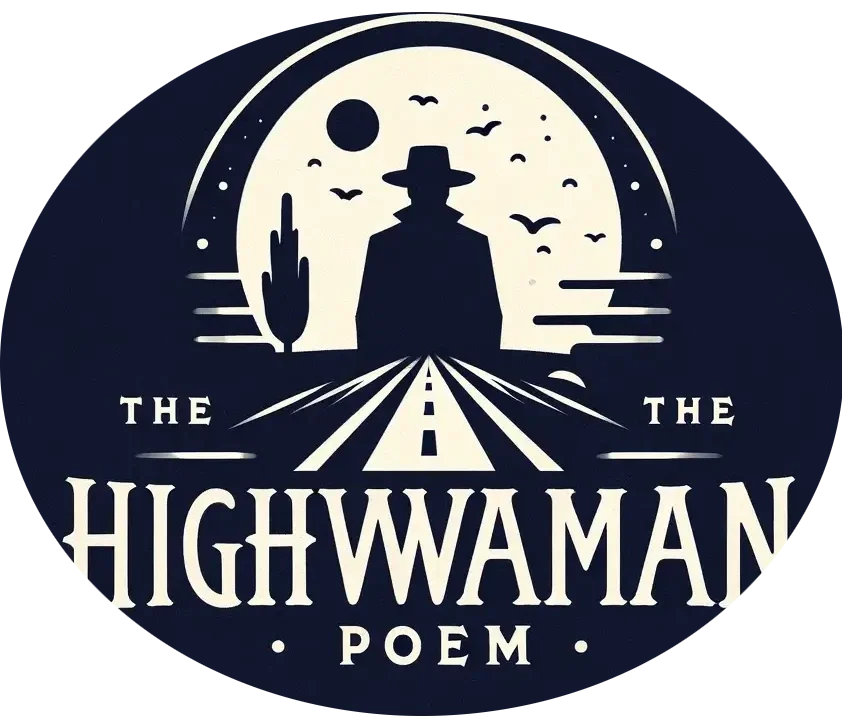The article investigates the themes, characters, and literary devices present in the renowned poem “The Highwayman” by Alfred Noyes. It provides a comprehensive overview of the plot and analyzes the poetic techniques employed in the composition. The examination extends to the impact of “The Highwayman” on its readership and draws comparisons with other literary works. The exploration aims to elucidate the intricacies of this enduring classic and emphasize its lasting importance in the realm of literature.
Key Takeaways:
- “The Highwayman” by Alfred Noyes is a narrative poem that explores themes of love, sacrifice, and loyalty through the tragic love story of the highwayman and Bess.
- The poem’s structure and use of literary devices, such as repetition and imagery, enhance the emotional impact and create a sense of suspense and danger.
- The characters of the highwayman and Bess are portrayed as heroic and passionate, while the villainous King George III serves as a symbol of oppression and injustice.
The Highwayman Poem Analysis: Themes, Characters, and Literary Devices
“The Highwayman,” a narrative poem composed by Alfred Noyes, is an enthralling narrative that intricately combines elements of romance, adventure, and tragedy. This literary work is distinguished by its rich themes, multifaceted characters, and an abundance of literary devices, all of which contribute to its enduring status as a timeless masterpiece in the realm of poetic literature.
Summary of ‘The Highwayman’
The poem ‘The Highwayman’ depicts the poignant love story between Bess, the daughter of the inn’s landlord, and the eponymous highwayman, taking place against the haunting backdrop of a moonlit setting surrounding an old inn-yard.
Throughout the narrative, the highwayman, distinguished by his dark attire and firearm, clandestinely visits Bess at the inn concealed beneath the moon’s radiant light. Their clandestine encounters are surreptitiously observed by Tim the ostler, who carries unreciprocated affections for Bess. By divulging the highwayman’s intentions to the Redcoats in exchange for his own safety, Tim inadvertently becomes the catalyst for the heart-wrenching denouement. In a selfless gesture to protect the highwayman, Bess sacrifices her own life by intercepting a bullet, tragically transforming their love saga into a poignant narrative of altruism and sorrow.
Key Poem Information
‘The Highwayman’ was initially published in 1906 by Alfred Noyes and is presented in the form of a narrative poem composed of several stanzas that interlace a poignant and sorrowful love tale.
The poem’s publication trajectory contributes to its allure, as it garnered acclaim for its distinctive fusion of romance, adventure, and suspense. Marked by a consistent rhyme scheme of AAABCC, the poem flows harmoniously, enriching its narrative essence. Noteworthy is the vivid imagery employed in ‘The Highwayman,’ which paints a highly detailed portrayal of the environment, allowing readers to almost sense the coldness of the wind and hear the echo of hoofbeats in the night. By skillfully employing repetition, Noyes establishes a rhythmic cadence that heightens the emotional richness of the storyline.
Structure and Narrative Flow of ‘The Highwayman’
The structural design of ‘The Highwayman’ plays a crucial role in establishing its rhythmic narrative flow, as each stanza contributes to the gradual increase of tension and the unfolding of the tragic storyline.
Throughout the progression of the poem across its various stanzas, the reader is drawn deeper into the intricate narrative of love, betrayal, and sacrifice. The rhythmic cadence of the poem, in conjunction with its meter and rhyme scheme, serves to create a heightened sense of urgency and suspense.
Of particular note are the stanzas that depict the pivotal encounter between Bess and the redcoats at the inn, as well as the final stanza where the Highwayman rides to his demise. These instances stand as vivid examples of how the poetic form enriches the emotional impact of the narrative. Through the repetition of key phrases and the deliberate arrangement of words within each stanza, the drama is further intensified, rendering ‘The Highwayman’ a captivating and enduring poetic masterpiece.
Themes Explored in ‘The Highwayman’
The poem ‘The Highwayman’ delves into several profound themes, most notably love, sacrifice, and death, intricately woven into the narrative to evoke deep emotional responses.
Through the tragic love story of the highwayman and Bess, the poem explores the depths to which individuals will go for love, highlighting how love can inspire both heroic acts of sacrifice and devastating betrayals. An example of this can be observed in Bess’s decision to shield the highwayman, even at the expense of her own life. The interplay between love and sacrifice is further underscored by the highwayman’s readiness to jeopardize everything for his beloved, culminating in a poignant conclusion.
The poem addresses the inevitability of death and betrayal, presenting a somber portrayal of how these elements can influence human lives and relationships.
Main Characters in ‘The Highwayman’
The primary characters in ‘The Highwayman’ consist of Bess, the steadfast and courageous daughter of the innkeeper; the gallant and sentimental highwayman; Tim, the ostler consumed by envy; and the persistent King George’s men.
Bess, displaying steadfast devotion to her father’s inn, embodies a quiet fortitude and resolve. She exhibits a strong protective instinct towards those dear to her and assumes a significant role in the storyline by becoming involved in the perilous romance with the enigmatic highwayman.
The highwayman himself emerges as a charismatic persona, renowned for his bold exploits and daring escapades beneath the nocturnal sky. Meanwhile, Tim, the jealous ostler, nurtures deep-seated animosity towards the highwayman and becomes a pivotal provocateur of the tragic occurrences that ensue.
The unrelenting pursuit by King George’s men introduces an element of urgency and peril to the unfolding plot, presenting a constant menace to the lives of our central characters.
Analysis of Literary Devices in ‘The Highwayman’
Alfred Noyes employs a diverse array of literary devices in his work “The Highwayman,” incorporating metaphors, similes, and vivid imagery to heighten the emotional and dramatic impact of the poem.
These literary devices work collaboratively to weave a tapestry of rich emotions and visuals throughout the poem. Through the use of metaphors, such as ‘the moon was a ghostly galleon‘ and ‘the tree was a ghostly gallows,’ the poem’s setting is imbued with depth and symbolism. Similes like ‘hair like moldy hay‘ and ‘eyes like coals‘ craft vibrant and evocative images within the reader’s imagination. Furthermore, the vivid imagery of the redcoats riding in the moonlight and Bess’s ultimate sacrifice at the conclusion instills a profound sense of tragedy and selflessness.
Collectively, these literary devices interact harmoniously to underscore the overarching themes of love, betrayal, and tragedy within the narrative, resulting in a compelling and enduring work of literature.
Analysis of Poetic Techniques in ‘The Highwayman’
The utilization of poetic techniques in ‘The Highwayman’, such as its rhythmic cadence, meter, and consistent rhyme scheme, serves as a pivotal element in establishing a haunting and melodic quality within the narrative.
The rhythmic cadence present in the poem, characterized by its measured beats and fluid rhythm, serves to captivate the reader’s attention and immerse them in the unfolding tale. It operates akin to a mesmerizing chant that resonates the thundering gallops of hooves. This pulsating meter, in conjunction with the steadfast ABAB rhyme scheme, heightens the dramatic effect and tension of the narrative, instilling a palpable sense of urgency and suspense.
Throughout the progression of the poem, the meticulously structured rhythm and rhyme synchronize harmoniously to evoke a timeless essence, effectively transporting the reader to a bygone era replete with highway robbers and star-crossed lovers.
Significant Quotes from ‘The Highwayman’
Several notable quotes from ‘The Highwayman’ are distinguished by their emotional depth and vivid imagery, exemplified by phrases like ‘The moon was a ghostly galleon tossed upon cloudy seas‘.
Of particular significance in the poem is the line, ‘But the landlord’s black-eyed daughter/Bess, the landlord’s daughter‘. This excerpt not only introduces the pivotal character, Bess, but also foreshadows the unfolding of a tragic love story. The description of the ‘black-eyed daughter‘ imbues Bess with an air of mystery and allure. Furthermore, the repetition of ‘the landlord’s daughter‘ serves to underscore her identity and establish the groundwork for the consequential events that transpire in the narrative.
Exploring the Impact of ‘The Highwayman’ on Readers
The profound impact of ‘The Highwayman’ on readers is often characterized by strong emotional reactions elicited through its thematic elements of love, sacrifice, and the evocative imagery that animates the narrative. The passionate love story between the Highwayman and Bess, unfolding amidst themes of betrayal and tragedy, not only resonates deeply with readers but also provides a poignant exploration of timeless values such as loyalty, courage, and the enduring nature of love. The poem’s haunting imagery, from the wind sweeping through the moonlit heath to the thunderous hooves on the highway, culminating in the tragic conclusion of the lovers, amalgamate to form a lasting impression that endures in the hearts and minds of those exposed to the tale.
Comparative Study: ‘The Highwayman’ and Other Poems
A comparison of ‘The Highwayman’ with other narrative poems reveals both similarities and differences in themes, style, and emotional impact.
Regarding themes, ‘The Highwayman’ shares commonalities with poems such as ‘The Lady of Shalott‘ and ‘Porphyria’s Lover‘ in its examination of love, betrayal, and tragic consequences. While ‘The Highwayman’ emphasizes selfless love and sacrifice, ‘The Lady of Shalott’ explores themes of isolation and artistic confinement, and ‘Porphyria’s Lover’ delves into the realms of possessiveness and obsession.
From a narrative perspective, ‘The Highwayman’ distinguishes itself through its vivid imagery and intense storytelling, reminiscent of Samuel Taylor Coleridge’s ‘The Rime of the Ancient Mariner’ in its incorporation of supernatural elements and captivating narration.
Frequently Asked Questions
What are the major themes present in The Highwayman poem?
The major themes presented in The Highwayman poem include love, loyalty, betrayal, and sacrifice.
Who are the main characters in The Highwayman poem?
The main characters in The Highwayman poem are the Highwayman, Bess, and Tim the ostler.
What literary devices are used in The Highwayman poem?
The Highwayman poem utilizes several literary devices such as personification, simile, metaphor, alliteration, and imagery.
How does the character of Bess symbolize love and loyalty in The Highwayman poem?
Bess symbolizes love and loyalty in The Highwayman poem through her unwavering devotion to the Highwayman and her ultimate sacrifice to save him from the Redcoats.
What is the significance of the setting in The Highwayman poem?
The setting of the poem, which is a remote inn on a dark and stormy night, adds to the dramatic and suspenseful atmosphere of the story.
How does the use of repetition enhance the impact of The Highwayman poem?
The repetition of certain phrases, such as “the wind was a torrent of darkness” and “the moon was a ghostly galleon,” creates a haunting and memorable effect and helps to build the tension and emotion in the poem.

